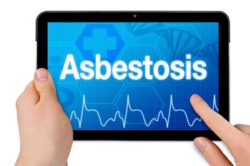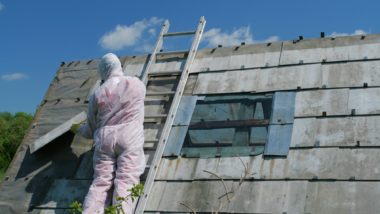Top Class Actions’s website and social media posts use affiliate links. If you make a purchase using such links, we may receive a commission, but it will not result in any additional charges to you. Please review our Affiliate Link Disclosure for more information.
Asbestos is a dangerous material that may cause health problems including asbestosis disease or cancer in those who are exposed to it.
About Asbestosis Disease
Asbestosis disease is a chronic health condition that affects the lungs. The disease is caused by the inhalation of tiny asbestos fibers or particles. The particles scar the inside of the lungs, resulting in a stiffening of the lung tissue as well as reduced lung function. It is a contributing cause of death for approximately 1,000 Americans every year.
Asbestosis Symptoms
Symptoms of asbestosis and other asbestos-related diseases often take years or decades to develop. By the time the symptoms become apparent, it is usually too late to halt the progression of these diseases.
The most common symptom of asbestosis is reduced lung capacity, resulting in shortness of breath. This symptom may be worsened by physical activity or it may be chronic. Other symptoms to watch for include clubbing, or widening, of the fingertips and toes, loss of appetite, unexplained weight loss, persistent cough, or chest pain and tightness. Symptoms that may be diagnosed by a doctor may include a low amount of oxygen in the lungs and a crackling sound heard when listening to the lungs through a stethoscope.
Asbestosis Treatment
Unfortunately, there is no cure for asbestosis. While there is no way to reverse the damage caused by the condition, some treatment options may help mitigate the symptoms and reduce the likelihood of further damage. For those with low blood oxygen levels or difficulty breathing, at-home oxygen therapy may be an option. Nebulizer medications or physiotherapy may be used to loosen secretions in the lungs or drain fluid. However, these treatments can only make people more comfortable, rather than reversing the course of the disease.
People with asbestosis may be at greater risk of developing associated conditions, including certain cancers, pneumococcal pneumonia, or influenza. Receiving vaccinations for preventable conditions may be advised for patients, as well as scheduling periodic exams, cancer screenings, and chest x-rays to keep an eye on any developing problems. People with the condition may also be advised to lower their risk factors or quit smoking in order to slow the progression of the disease.
Potential Complications
People diagnosed with asbestosis may also be at an increased risk of developing lung cancer. Smokers or former smokers may be especially at risk, due to the irritation caused to lungs by cigarette smoke. In addition to traditional cigarettes, vaping may also be harmful to people with asbestosis. People who develop asbestosis-related lung cancer may require surgery to remove tumors or growths from their lungs as well as chemotherapy, radiation, or immunotherapy. In some cases, patients may be put on a waiting list to receive a lung transplant.
Lung cancer is a very serious type of cancer. Only about 18 percent of people diagnosed with the condition survive for more than five years after diagnosis. More than half of lung cancer patients die within a year.
 Asbestosis Disease Risk Factors
Asbestosis Disease Risk Factors
Asbestosis is caused by exposure to asbestos. Although there are regulations regarding the use of asbestos in products, many people work in occupations that may increase their exposure to the material. Occupations that may put people at additional risk of asbestos exposure include mining, mechanical or automotive work, construction, electrical work, railroad or shipyard work, refineries and mills, and factories. While there are laws requiring employers to provide a safe working environment for employees, many who work in these fields may be unaware of the dangers of asbestos and thus not wear proper protective equipment. Since the symptoms of asbestos-related diseases or cancers take years or decades to develop, people may not be aware of their exposure until it is too late.
Additionally, those who work in occupations where they come into contact with asbestos may unknowingly bring the material home to their families. Asbestos particles are so small that they cannot be seen, so these fibers may adhere to the skin, hair, clothing, or shoes. Workers who don’t change clothing or shower before coming home from work may bring these particles home, where they can be inhaled by spouses or children. Secondhand exposure to asbestos may be just as hazardous as first-hand exposure.
Others may be exposed to asbestos from common household products. As asbestos is often mined near talc, household products such as baby powder or cosmetics containing talc may be contaminated with the mineral.
About Asbestos
Asbestos is a naturally occurring fibrous mineral mined from the earth and used in many manufactured products. However, exposure to the mineral may be dangerous. While asbestos is used in products such as insulation, roofing, construction materials, brakes and automotive parts, tiles, textiles, heat resistant fabrics, and other goods, the material may be hazardous to human health if it is ingested or inhaled. When asbestos fibers are whole and intact, they may not pose a threat. However, if the mineral degrades or breaks, tiny fibers are released into the air where they may be inhaled or eaten unknowingly. Many old schools or office buildings have insulation, flooring, or ceiling tiles made from asbestos. When these materials break down or are damaged, fibers may be released into the air.
When asbestos fibers are inhaled, they can settle in the lungs or other internal organs. The small fibers can cause irritation and inflame the surrounding tissue. Over time, this irritation may become scar tissue, or lead to chronic or serious health conditions including mesothelioma, lung cancer, or asbestosis disease.
Asbestos Ban?
Though the link between asbestos disease and materials used in building, manufacturing, and other materials has resulted in much less use of the material, asbestos has not been entirely banned in the United States. In fact, asbestos can still be used in roofing, fireproofing materials, friction products, and other items.
In fact, U.S. regulators have proposed expanding the use of asbestos. According to a report by PBS News Hour, in 2018 the Environmental Protection Agency (EPA) proposed rules that would allow the use of asbestos in additional products, including adhesives and sealants, beater-add gaskets, millboard, floor tile, and other building materials.
For decades, groups opposing the use of asbestos have tried, but failed, to pass a blanket ban on the fibers in the United States, according to News Hour. Since 1975, the EPA has outlawed asbestos in building materials, starting with pipe insulation and slowly expanding the prohibition. PBS reports that by 1989, the agency’s rule acted as a near-total ban on the use of the substance under the Toxic Substances Control Act.
However, in 1991, a court vacated the EPA’s rules, and as a result, companies were able to import and manufacture products with asbestos.
Now, the EPA reportedly claims that the proposed new rules would close loopholes that allow the use of asbestos in light of the court ruling. Opponents say that because other laws have changed, the EPA’s proposed rule would, in reality, expand the use of asbestos in the United States.
If you have developed asbestosis or another asbestos-related condition due to exposure to the dangerous material through your occupation, you may be eligible to file a class action lawsuit and pursue compensation. A qualified attorney may be able to review your case and determine whether you qualify to join or file a lawsuit.
Join a Free Asbestos Cancer Class Action Lawsuit Investigation
If you or a loved one have been exposed to asbestos and were subsequently diagnosed with the following asbestos-related illnesses:
- Mesothelioma
- Lung cancer
- Larynx cancer
- Esophageal cancer
- Colon cancer
- Pulmonary asbestosis
- Asbestos-related pleural disease,
… then you may be eligible to file an asbestos lawsuit to seek compensation for your medical expenses, lost wages, pain and suffering, and other losses you have experienced.
If your loved one has passed away, you may also be able to file a wrongful death lawsuit to seek compensation for funeral expenses and other costs associated with your loved one’s illness.
Obtain a free case review now by filling out the form on this page.
An asbestos attorney will contact you if you potentially qualify to file an asbestos lawsuit or class action lawsuit. There is no cost or obligation associated with this case evaluation.
ATTORNEY ADVERTISING
Top Class Actions is a Proud Member of the American Bar Association
LEGAL INFORMATION IS NOT LEGAL ADVICE
Top Class Actions Legal Statement
©2008 – 2024 Top Class Actions® LLC
Various Trademarks held by their respective owners
This website is not intended for viewing or usage by European Union citizens.
Get Help – It’s Free
Join a Free Asbestos Cancer Class Action Lawsuit Investigation
If you qualify, an attorney will contact you to discuss the details of your potential case at no charge to you.
PLEASE NOTE: If you want to participate in this investigation, it is imperative that you reply to the law firm if they call or email you. Failing to do so may result in you not getting signed up as a client or getting you dropped as a client.
E-mail any problems with this form to:
Questions@TopClassActions.com.
Oops! We could not locate your form.


 Asbestosis Disease Risk Factors
Asbestosis Disease Risk Factors









